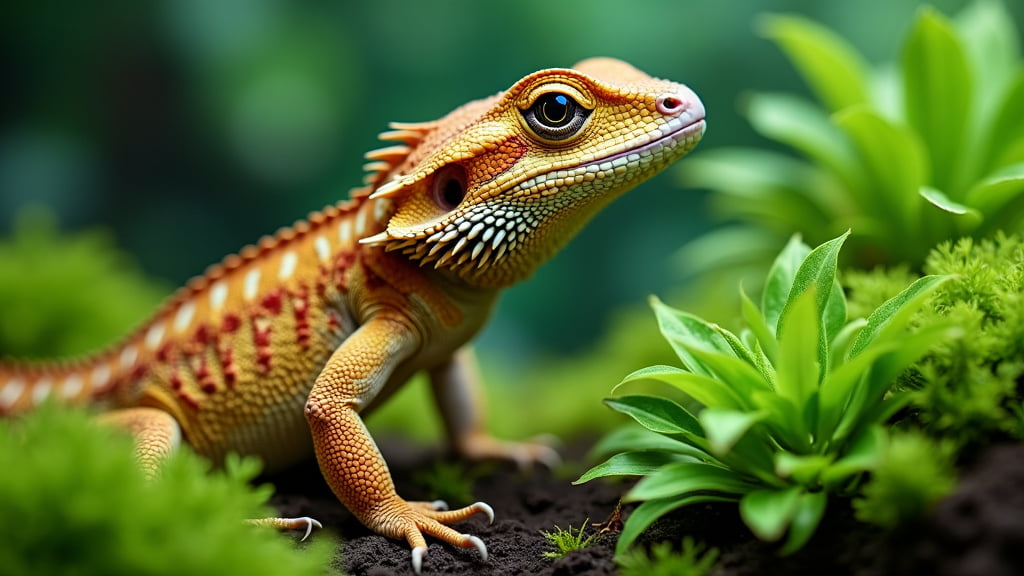Safe Plants for Bearded Dragon Tanks: A Comprehensive Guide
Introduction
Bearded dragons (Pogona vitticeps) are fascinating pets that have captured the hearts of reptile lovers everywhere, including mine! One of the most vital aspects of owning a bearded dragon is creating a safe and comfortable tank setup. In this post, we’ll dive into the world of safe plants for bearded dragon tanks, providing you with practical advice, expert insights, and some real-life examples from my own experiences.
Why Safe Plants Matter for Your Bearded Dragon
Adding plants to your bearded dragon’s tank does more than improve aesthetics. It plays a crucial role in their well-being. Here’s why:
Enhancing the Environment
- Natural Hiding Spots: Plants create natural hiding and climbing spots, which help replicate a wild habitat, crucial for your dragon’s mental stimulation.
- Humidity Control: Live plants can assist in maintaining the right humidity levels, which is particularly important in a glass terrarium.
- Air Purification: Some plants can help improve air quality within the tank, though ventilation should always be priority number one.
Using safe plants also ensures that any accidental nibbles don’t end up causing harm, which brings us to our next point: Safety.
Safety Considerations
While many plants are beneficial, others can be toxic or hazardous. It’s crucial to select plants that are non-toxic and appropriate for the bearded dragon’s environment. This involves understanding your pet’s natural behaviours and the plant’s properties.
Top Safe Plants for Bearded Dragon Tanks
Here are my top recommendations for safe and beneficial plants to include in your bearded dragon’s tank:
Spider Plant (Chlorophytum comosum)
Spider plants are a fantastic choice due to their durability and low maintenance.
- Pros:
- Non-toxic and safe for bearded dragons.
- Resilient and easy to care for.
- Cons:
- Can be prone to browning tips in low humidity environments.
One of my bearded dragons, Spike, took a particular liking to the spider plant. It provided him with a natural hideaway, and I noticed his activity levels increased as he enjoyed exploring around it.
Aloe Vera
Aloe vera is not only safe but also beneficial due to its medicinal properties.
- Pros:
- Non-toxic and edible.
- Moisture-retentive leaves can help with humidity.
- Cons:
- Requires bright light to thrive, which works well under UVB lighting in the tank.
I once used aloe vera for Gizmo, my other bearded dragon, when he had a slight skin irritation. Although the aloe in the tank was more for ambiance, it underscored the utility of having multi-functional plants in the habitat.
Hibiscus (Hibiscus rosa-sinensis)
Hibiscus plants can add a splash of colour to your dragon’s tank.
- Pros:
- Edible flowers and leaves.
- Provides a decorative and enriching environment.
- Cons:
- Needs sufficient light and can be quite thirsty.
Max, another one of my bearded dragons, adored the hibiscus plant in his tank. He occasionally nibbled at the flowers, and it was a joy watching him enjoy his environment.
Tips for Incorporating Live Plants
To ensure the best experience for your bearded dragon, here are some additional tips:
Plant Placement
- Ensure plants are placed securely to avoid tipping.
- Avoid areas where your dragon might dig them up.
Lighting and Watering Requirements
- Match the plant’s lighting needs with your tank’s conditions.
- Overwatering can lead to mould, which can be harmful to your bearded dragon.
Maintenance and Monitoring
- Regularly check for any signs of plant decay or mould.
- Remove any plant that shows signs of illness to prevent spreading.
By following these guidelines, you create a harmonious habitat where both plants and dragons thrive.
Conclusion
Creating a naturalistic environment using safe plants not only benefits your bearded dragon but also enhances their quality of life. With careful selection and regular maintenance, you can cultivate an attractive and secure habitat. Whether you’re a first-time bearded dragon owner or an experienced reptile enthusiast, incorporating plants like spider plants, aloe vera, and hibiscus can make a significant difference.
For readers looking to deepen their understanding further, I recommend checking out our in-depth resource on bearded dragon tank setup. Always consult with a vet for any health concerns related to your bearded dragon.
Do you have any favourite plants or unique setups for your bearded dragon? Share your experiences in the comments below!
By following these steps, you’ll not only enhance your bearded dragon’s habitat but also create a more enjoyable experience for yourself as a pet owner. Happy tank decorating!
Check out this recommended product for your bearded dragon’s tank setup

